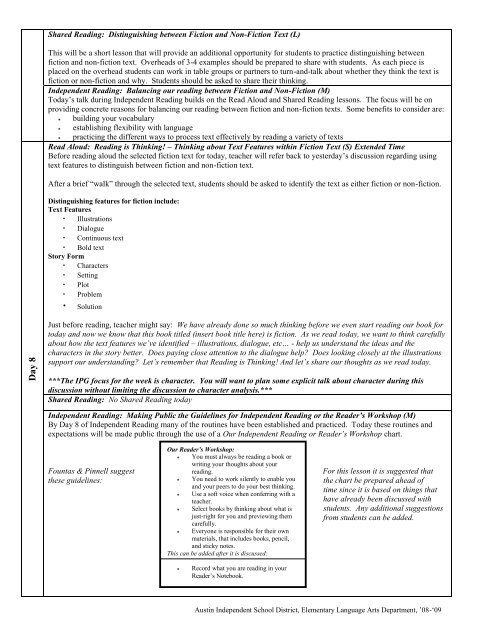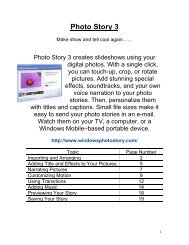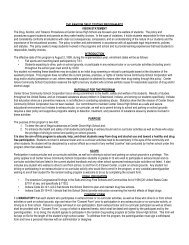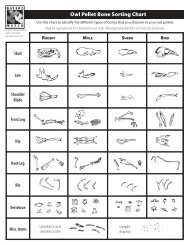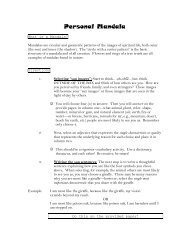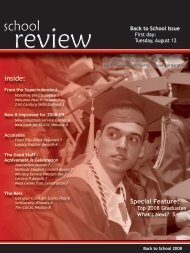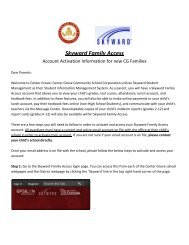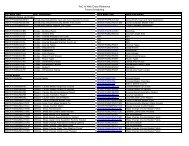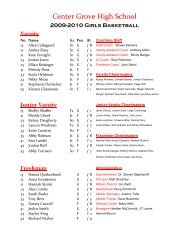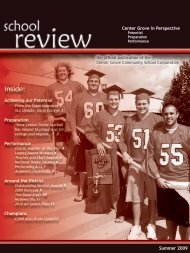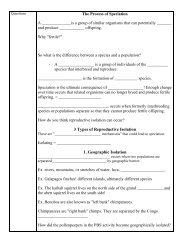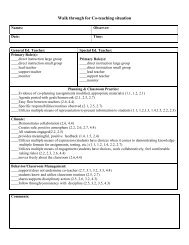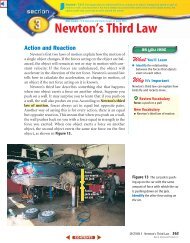The First 20 Days of Reading: Intermediate - Center Grove ...
The First 20 Days of Reading: Intermediate - Center Grove ...
The First 20 Days of Reading: Intermediate - Center Grove ...
You also want an ePaper? Increase the reach of your titles
YUMPU automatically turns print PDFs into web optimized ePapers that Google loves.
Day 8<br />
Shared <strong>Reading</strong>: Distinguishing between Fiction and Non-Fiction Text (L)<br />
This will be a short lesson that will provide an additional opportunity for students to practice distinguishing between<br />
fiction and non-fiction text. Overheads <strong>of</strong> 3-4 examples should be prepared to share with students. As each piece is<br />
placed on the overhead students can work in table groups or partners to turn-and-talk about whether they think the text is<br />
fiction or non-fiction and why. Students should be asked to share their thinking.<br />
Independent <strong>Reading</strong>: Balancing our reading between Fiction and Non-Fiction (M)<br />
Today‟s talk during Independent <strong>Reading</strong> builds on the Read Aloud and Shared <strong>Reading</strong> lessons. <strong>The</strong> focus will be on<br />
providing concrete reasons for balancing our reading between fiction and non-fiction texts. Some benefits to consider are:<br />
building your vocabulary<br />
establishing flexibility with language<br />
practicing the different ways to process text effectively by reading a variety <strong>of</strong> texts<br />
Read Aloud: <strong>Reading</strong> is Thinking! – Thinking about Text Features within Fiction Text (S) Extended Time<br />
Before reading aloud the selected fiction text for today, teacher will refer back to yesterday‟s discussion regarding using<br />
text features to distinguish between fiction and non-fiction text.<br />
After a brief “walk” through the selected text, students should be asked to identify the text as either fiction or non-fiction.<br />
Distinguishing features for fiction include:<br />
Text Features<br />
• Illustrations<br />
• Dialogue<br />
• Continuous text<br />
• Bold text<br />
Story Form<br />
• Characters<br />
• Setting<br />
• Plot<br />
• Problem<br />
• Solution<br />
Just before reading, teacher might say: We have already done so much thinking before we even start reading our book for<br />
today and now we know that this book titled (insert book title here) is fiction. As we read today, we want to think carefully<br />
about how the text features we’ve identified – illustrations, dialogue, etc… - help us understand the ideas and the<br />
characters in the story better. Does paying close attention to the dialogue help Does looking closely at the illustrations<br />
support our understanding Let’s remember that <strong>Reading</strong> is Thinking! And let’s share our thoughts as we read today.<br />
***<strong>The</strong> IPG focus for the week is character. You will want to plan some explicit talk about character during this<br />
discussion without limiting the discussion to character analysis.***<br />
Shared <strong>Reading</strong>: No Shared <strong>Reading</strong> today<br />
Independent <strong>Reading</strong>: Making Public the Guidelines for Independent <strong>Reading</strong> or the Reader’s Workshop (M)<br />
By Day 8 <strong>of</strong> Independent <strong>Reading</strong> many <strong>of</strong> the routines have been established and practiced. Today these routines and<br />
expectations will be made public through the use <strong>of</strong> a Our Independent <strong>Reading</strong> or Reader’s Workshop chart.<br />
Fountas & Pinnell suggest<br />
these guidelines:<br />
Our Reader’s Workshop:<br />
You must always be reading a book or<br />
writing your thoughts about your<br />
reading.<br />
You need to work silently to enable you<br />
and your peers to do your best thinking.<br />
Use a s<strong>of</strong>t voice when conferring with a<br />
teacher.<br />
Select books by thinking about what is<br />
just-right for you and previewing them<br />
carefully.<br />
Everyone is responsible for their own<br />
materials, that includes books, pencil,<br />
and sticky notes.<br />
This can be added after it is discussed:<br />
Record what you are reading in your<br />
Reader‟s Notebook.<br />
For this lesson it is suggested that<br />
the chart be prepared ahead <strong>of</strong><br />
time since it is based on things that<br />
have already been discussed with<br />
students. Any additional suggestions<br />
from students can be added.<br />
Austin Independent School District, Elementary Language Arts Department, ‟08-„09


